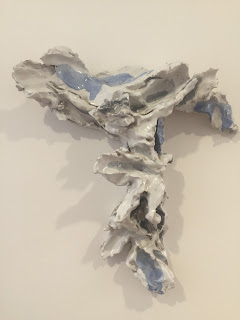 |
| Raymond Hains, Untitled, 1990 |
Albert Oehlen’s Untitled, 2017, commissioned for this exhibition, dispels all doubt
about the ambiguity of grey. The colour chart that moves from what we might
call grey to blue to brown to white showing that, in fact, any colour might be
grey if seen in the right light. And vice
versa, grey can become any other colour if seen from a given perspective,
by a particular culture, in a specific historical moment. As Wittgenstein
reminds us, we call grey, like all other colours, is always at the mercy of
language, the words that we give to that peculiar cast of light on the surface
before our eyes. I have no idea if it is Oehlen’s intention to cast the definition
of grey into question, but this is what came to mind as I stood before this
work that seems unrelated to everything he has done until now. While the form
of the colour chart is nothing new—and visitors will be reminded of Gerhard
Richter’s works of the same genre—its placement here at the entrance to Matière Grise as a claim about grey, is
innovative.
 |
| Albert Oehlen, Untitled, 2017 |
The exhibition confirms all my convictions that
grey is the most exciting colour. While each work on exhibition has some kind
of value, the curation is what makes this show fascinating. Matière Grise brings together all of the
materials in our world that are grey: steel, clay, oil, spray paint on cars, aluminium,
charcoal and of course, paint. The exhibition consists of pieces ranging from
Raymond Hains, Untitled (1990) made
up of posters torn from the streets stuck on stainless steel, through Edmund de
Waal’s still life of a pot, a book with a gold leaf leaning against it inside a
small box, to a rock by Navid Nuur, enamelled and with indentations in which iron
shavings are nestled. All of this matter is grey, and together, they remind us
that grey matters.
My favourite of the individual pieces is
Loris Gréaud’s Trajectories, 2017. Car waste oil has been smeared across absorbent
paper, mounted and framed in black oak. The bevelled edges of the paper which
is mounted on board and then made precious through a frame. The unevenness of
the paper on which the oil is smeared thus becomes foregrounded and similarly
makes the oil as medium poetic. The oil raises many associations; the cars from
which it has been wasted, the environment from which it has robbed, the economy
it turns around, remind us that oil is such a politically and economically
potent substance. And here, in Trajectories,
oil makes paper sensuous and aesthetically pleasing, and in turn, delicate.
 |
| Jérémy Demester, Vin d'Anjou IX, 2017 |
It is interesting to note that all the
pieces are abstract, and all are tactile, material and or sumptuous surfaces. And
like Trajectories they all engage
some form of transformation, either of the material or the grey. Each piece
therefore reflects back on the colour grey. The shiny reflective surface of Jérémy
Demester’s, Vin d’Anjoy IX, 2017 is
hung opposite Gréaud’s Trajectories and
looks blue by comparison, across the other side of the room. The two are in
conversation, reflecting on their differences—reflective opposite absorbent—and
through juxtaposition, their own materiality. In this example, we see how grey
has the capacity to make ethereal substances material—oil, water, air, and of
course, paint are made into things, distinct, but dependent on each other for definition.
We see this transformation, literally, in the fourth panel of Hains’ Untitled. A horizontal blue line about
1/3 of the way down the panel turns blu paint into water, a substance. Materiality
is also the conversation had by the objects of de Waal’s Tobias and his angel (2017): the objects in the box are ceramic,
graphite, glass, aluminium, plexiglass, and all come together to transcend
their individual identity and significance.
 |
| Günter Förg, Untitled, 2001 |
The question I came away with: why is it
that grey is always rendered through abstraction? I don’t know the definitive
answer, but I am convinced that artists turn to grey to pose the questions and
problems that preoccupy, but cannot be examined through representation. Grey is
a stripping back of the concerns of the aesthetic, and therefore, questions are
resolved in grey where other colours have no idea. Thus, Günther Förg’s ribbons
of dark grey on a lighter grey background ask questions about background and
foreground, the difference between line and ground, between chaos and order, labyrinthine
possibilities.
My commitment to grey stems from the fact
that grey has to work with other colours, in different materials in order for
its brilliance to shine through. Grey doesn’t have an easy life. And this
exhibition is memorable because it is only in the coming together of the
different works that all of this magic happens in the Max Hetzler gallery.
All images copyright Max Hetzler Gallery













